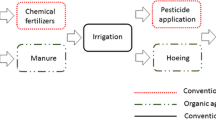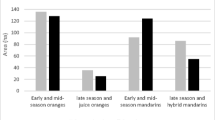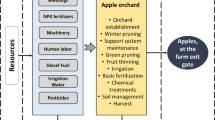Abstract
Although the conventional farming system (CV) for apple production remains the common practice worldwide, the organic farming system (OF) is becoming increasingly important. Few global assessments of the environmental impacts of organic orchard systems are currently available. In this work, we analyse the weak and strong points of the environmental performance of the growing phase of two organic and one conventional apple orchard, using a pluri-annual dataset from experimental orchard systems located in the Middle Rhone valley in France, with life cycle analysis (LCA). LCA, also referred to as cradle-to-grave analysis, allows a quantitative and global evaluation of an orchard’s environmental performance. The analysis was performed using the SALCA (Swiss Agricultural Life Cycle Assessment) method (SALCA-Crop V3.1, adapted for pome fruit) and included relevant impact categories based on characterisation models derived mainly from the EDIP97 and CML01 methods, as well as those developed by Agroscope (ART).
Seven impact categories that included ecotoxicity and human toxicity, as well as energy consumption and other environmental impact categories, were calculated and are discussed here. The OF systems appeared to have less of an impact than the conventional system, considering the surface-based functional unit (ha/year). However, the basic substitution of conventional with organic inputs or mechanised activities was not sufficient to radically improve the overall environmental performance of the orchard systems. These results need several years of full production to be validated.
Access this chapter
Tax calculation will be finalised at checkout
Purchases are for personal use only
Similar content being viewed by others
Notes
- 1.
http://www.eu-footprint.org/ (10.02.2010)
- 2.
e.g. input productions and machinery use
- 3.
compounds applied in the three management systems of apple orchards causing either aquatic or terrestrial ecotoxicity
References
Anton A, Castells F, Montero JI, Huijbregts M (2004) Comparison of toxicological impacts of integrated and chemical pest management in Mediterranean greenhouses. Chemosphere 54:1225–1235
Bockstaller C, Guichard L, Keichinger O, Girardin P, Galan MB, Gaillard G (2009) Comparison of methods to assess the sustainability of agricultural systems. A review. Agro Sustain Develop 29:223–235
Cowell SJ, Clift R (1997) Impact assessment for LCAs Life Cycle Assessments involving agricultural production. International J Life Cycle Assess 2:99–103
Gaillard G, Nemecek T (2009) Swiss Agricultural Life Cycle Assessment (SALCA): an integrated environmental assessment concept for agriculture. Proceedings of the Conference on integrated assessment of agriculture and sustainable development: Setting the Agenda for Science and Policy (AgSAP 2009), Hotel Zuiderduin, Egmond aan Zee, The Netherlands, 10–12 March 2009, pp. 134–135
Guinée JB, Gorrée M, Heijungs R, Huppes G, Kleijn R, de Koning A, van Oers L, Wegener Sleeswijk A, Suh S, Udo de Haes HA, de Bruijn H, van Duin R, Huijbregts MAJ, Lindeijer E, Roorda AAH, Weidema BP (2001) Life cycle assessment—an operational guide to the ISO standards. Ministry of Housing, Spatial Planning and Environment (VROM) and Centre of Environmental Science (CML), Den Haag and Leiden, Netherlands
Gutsche V, Rossberg D (1997) SYNOPS 1.1: a model to assess and to compare the environmental risk potential of active ingredients in plant protection products. Agr Ecosyst Environ 64:181–188
Gutsche V, Strassemeyer J (2007) SYNOPS—a model to assess the environmental risk potential of pesticides. Nachrichtenblatt des Deutschen Pflanzenschutzdienstes 59:197–210
Haas G, Wetterich F, Kopke U (2001) Comparing intensive, extensified and organic grassland farming in southern Germany by process life cycle assessment. Agr Ecosyst Environ 83:43–53
Hauschild M, Wenzel H (1998) Environmental assessment of products: scientific background. Chapman & Hall, London
Hayashi K, Nakagawa A, Itsubo N, Inaba A (2006) Expanded damage function of stratospheric ozone depletion to cover major endpoints regarding life cycle impact assessment. Int J Life Cycle Assess 11:150–161
Hischier R, Weidema B, Althaus HJ, Bauer C, Doka G, Dones R, Frischknecht R, Hellweg S, Humbert S, Jungbluth N, Köllner T, Loerinick Y, Margni M, Nemecek T (2009) Implementation of life cycle impact assessment methods In: Inventories S.C.f.L.C. (ed), Ecoinvent report, Dübendorf
Jolliet O, Muller-Wenk R, Bare J, Brent A, Goedkoop M, Heijungs R, Itsubo N, Pena C, Pennington D, Potting J, Rebitzer G, Stewart M, de Haes HU, Weidema B (2004) The LCIA midpoint-damage framework of the UNEP/SETAC life cycle initiative. Int J Life Cycle Assess 9:394–404
Kägi T, Bockstaller C, Gaillard G, Hayer F, Mamy L, Strassemer J (2008a) Multicriteria comparison of RA and LCA toxicity methods with focus on pesticide application strategies. 6th International Conference on Life Cycle Assessment in the Agri-Food Sector, Zurich, p. 414
Kägi T, Casado D, Delval P, Gaillard G, Otto S, Strassemeyer J (2008b) Life cycle assessment of integrated and organic apple production systems in Europe. In: Network E (ed), Endure network meeting
Milà i Canals L, Burnip GM, Cowell SJ (2006) Evaluation of the environmental impacts of apple production using Life Cycle Assessment (LCA): case study in New Zealand. Agr Ecosyst Environ 114:226–238
Mouron P, Scholz RW, Nemecek T, Weber O (2006) Life cycle management on Swiss fruit farms: relating environmental and income indicators for apple-growing. Ecol Eco 58:561–578
Nemecek T, Erzinger S (2005) Modelling representative life cycle inventories for Swiss arable crops. Int J Life Cycle Assess 10:68–76
Nemecek T, von Richthofen JS, Dubois G, Casta P, Charles R., Pahl H (2008) Environmental impacts of introducing grain legumes into European crop rotations. Euro J Agro 28:380–393
Nemecek T, Dubois D, Huguenin-Elie O, Gaillard G (2011) Life cycle assessment of Swiss farming systems: I. Integrated and organic farming. Agr Syst 104:217–232
Rebitzer G, Ekvall T, Frischknecht R, Hunkeler D, Norris G, Rydberg T, Schmidt WP, Suh S, Weidema BP, Pennington DW (2004) Life cycle assessment Part 1: Framework, goal and scope definition, inventory analysis, and applications. Environ Int 30:701–720
Reganold JP, Glover JD, Andrews PK, Hinman HR (2001) Sustainability of three apple production systems. Nature 410:926–930
Rickerl D, Francis C (2004) Multidimentional thinking: a prerequisite to agroecology. In: Al-Amoodi L, Barbarick KA, Roberts CA, Dick WA (eds), Agroecosystems analysis. American Society of Agronomy, Inc. Crop Science Society of America, Inc., Soil Science Society of America, Inc., Madison, Wisconsi, USA, pp. 1–17
Sauphanor B, Dirwimmer C, Boutin S, Chaussabel A-L, Dupont N, Fauriel J, Gallia V, Lambert N, Navarro E, Parisi L, Plenet D, Ricaud V, Sagnes J-L, Sauvaitre D, Simon S, Speich P, Zavagli, F (2009) ECOPHYTO R & D vers des systèmes de culture économes en produits phytosanitaires. INRA, p. 68
Simon S, Brun L, Guinaudeau, J., Sauphanor B (2011) Pesticide use in current and innovativbe apple orchard systems. Agro Sustain Develop 31:541–555
Xavier JHV, Caldeira-Pires A (2004) Potencial use of Life Cycle Assessment (LCA) methodology for characterization of agriculture environmental impacts. CC & T, Cadernos de Ciencia & Tecnologia 21, 311–341
Author information
Authors and Affiliations
Corresponding author
Editor information
Editors and Affiliations
Appendix 1: List of Pesticides and CML Toxicity Coefficient Used for Calculation
Appendix 1: List of Pesticides and CML Toxicity Coefficient Used for Calculation
Reference: SYNOPS database, see description in material and methods.
Active ingredient | Pesticide class | CML aquatic tox | CML terrestrial tox | CML human tox |
|---|---|---|---|---|
Acetamiprid | Cyclic N-compounds | 4.17E − 03 | 9.79E − 04 | 1.53E + 00 |
Acetic acid | Pesticide unspecified | 9.61E − 01 | 8.17E − 02 | 7.04E + 00 |
Aminotriazole | Cyclic N-compounds | 1.32E + 00 | 4.82E − 02 | 9.27E + 01 |
Ammonium thiocyanate | Pesticide unspecified | 7.90E + 01 | 5.18E + 01 | 7.04E + 00 |
Azinphos-methyl | Organophosphorus-compounds | 3.07E + 01 | 2.04E + 01 | 2.08E + 01 |
Beta-cyfluthrin | Pyretroid-compounds | 8.88E + 00 | 1.35E + 01 | 1.35E + 01 |
Bupirimate | Cyclic N-compounds | 2.27E + 00 | 2.32E − 01 | 1.26E + 01 |
Bacillus thurengensis | Pesticide unspecified | 0.00E + 00 | 0.00E + 00 | 0.00E + 00 |
Calcium chloride | Pesticide unspecified | 9.61E − 01 | 8.17E − 02 | 7.04E + 00 |
Captan | Phtalamide-compounds | 2.83E − 03 | 1.44E − 02 | 1.72E − 01 |
Carbaryl | [Thio]Carbamate-compounds | 1.63E − 01 | 6.87E − 02 | 5.15E + 01 |
Chlorpyrifos-methyl | Organophosphorus-compounds | 6.17E + 01 | 2.64E + 01 | 5.02E − 01 |
Copper | Pesticide unspecified | 5.55E + 01 | 1.48E + 00 | 9.61E + 00 |
Difenoconazole | Cyclic N-compounds | 6.36E + 01 | 2.90E + 00 | 5.59E + 01 |
Dithianon | Nitrile-compounds | 4.24E − 03 | 7.42E − 03 | 3.00E − 02 |
Diquat | Bipyridylium-compounds | 4.57E + 02 | 5.06E + 02 | 2.06E + 03 |
Dodine | Pesticide unspecified | 9,61E − 01 | 8,17E − 02 | 5,04E − 04 |
E, e−8, 10-dodecadiene−1-ol | Pesticide unspecified | 0,00E + 00 | 0,00E + 00 | 0,00E + 00 |
Ethephon | Organophosphorus-compounds | 1,17E − 02 | 5,86E − 03 | 9,35E − 02 |
Flonicamid | Cyclic N-compounds | 1,07E − 01 | 6,57E − 03 | 8,08E + 00 |
Fluazifop-P-butyl | Diphenylether-compounds | 7,64E − 03 | 5,49E − 03 | 8,10E + 00 |
Fludioxonil | Nitrile-compounds | 4.02E − 02 | 1.17E − 02 | 3.73E − 02 |
Glufosinate-ammonium | Pesticide unspecified | 1.55E − 03 | 2.46E − 04 | 1.26E + 00 |
Glyphosate | Organophosphorus-compounds | 7.75E − 05 | 9.91E − 06 | 8.90E − 03 |
Granulosevirus | Pesticide unspecified | 0.00E + 00 | 0.00E + 00 | 0.00E + 00 |
Isoxaben | Acetamide-anillide-compounds | 1.48E + 00 | 8.70E − 02 | 1.24E + 01 |
Kresoxim-methyl | Pesticide unspecified | 1.76E + 01 | 9.20E − 01 | 2.62E − 01 |
Mancozeb | Dithiocarbamate-compounds | 6.38E − 04 | 9.30E − 04 | 1.08E − 02 |
Oryzalin | Dinitroaniline-compounds | 1.45E − 1 | 2.69E − 02 | 1.09E + 1 |
Oxydemeton-methyl | Organophosphorus-compounds | 2.42E + 01 | 2.40E + 00 | 1.29E + 03 |
Paraffin (C18–C30) | Pesticide unspecified | 4.02E − 4 | 5.2143E−05 | 0.00E + 00 |
Paraffin (C11–C25) | Pesticide unspecified | 2.33E − 3 | 6.33E−3 | 0.00E + 00 |
Pyridaben | Pesticide unspecified | 8.96E + 1 | 1.71E + 2 | 1.05E + 2 |
Phosmet | Organophosphorus-compounds | 2.34E − 02 | 6.45E − 02 | 8.91E − 02 |
Pyrimethanil | Acetamide-anillide-compounds | 1.03E + 02 | 4.03E + 00 | 8.46E + 00 |
Rotenone | Pesticide unspecified | 4.50E − 02 | 3.69E − 02 | 7.04E + 00 |
Spinosad | Pesticide unspecified | 3.65E − 01 | 3.58E − 02 | 2.20E − 01 |
Sulfur | Pesticide unspecified | 1.04E − 1 | 2.32E − 2 | 0.00E + 00 |
Thiacloprid | Nitrile-compounds | 4.64E − 03 | 1.00E − 03 | 1.37E + 00 |
Thiophanate-methyl | [Thio]Carbamate-compounds | 2.63E − 01 | 2.44E − 02 | 2.15E + 00 |
Rights and permissions
Copyright information
© 2014 Springer Science+Business Media Dordrecht
About this chapter
Cite this chapter
Alaphilippe, A., Simon, S., Hayer, F. (2014). Using Life Cycle Analysis to Analyse the Environmental Performances of Organic and Non-organic Apple Orchards. In: Bellon, S., Penvern, S. (eds) Organic Farming, Prototype for Sustainable Agricultures. Springer, Dordrecht. https://doi.org/10.1007/978-94-007-7927-3_12
Download citation
DOI: https://doi.org/10.1007/978-94-007-7927-3_12
Published:
Publisher Name: Springer, Dordrecht
Print ISBN: 978-94-007-7926-6
Online ISBN: 978-94-007-7927-3
eBook Packages: Biomedical and Life SciencesBiomedical and Life Sciences (R0)




